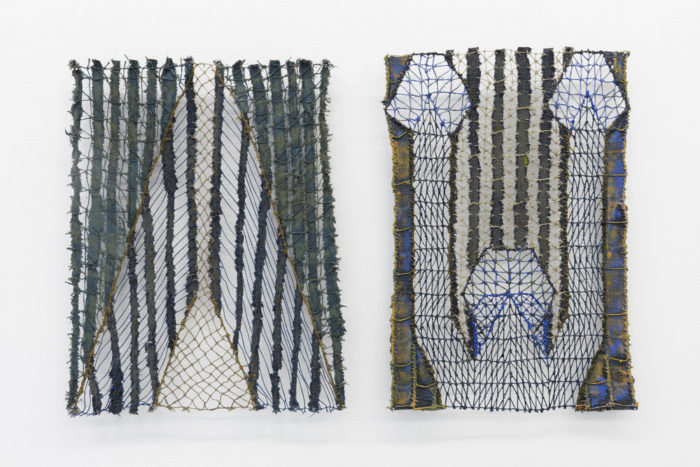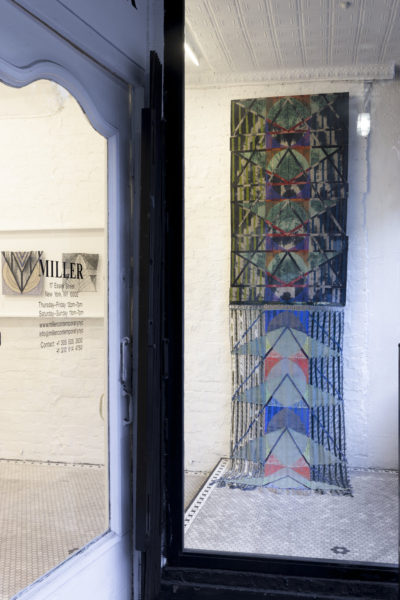
MILLER
MILLER is a very quaint space on the Lower East Side. With its original tile flooring and intimate feel, it’s the perfect little place to showcase works of art. Julia Bland’s show blends in with the architecture of the room as though it belongs there, and takes the viewer on a unique journey.

Movement
It’s always fascinating when an artist can take static materials and transform them into something that seems to move. Ms. Bland’s use of geometry, the interplay of mixed materials, and color choices all contribute to the appearance of movement in her work.
When you walk in to see the current show, the first thing you’ll likely notice is the large hanging canvass in the middle of the gallery. I went right for it, studying it carefully. It’s called “Undertow” and has a definite feeling of upward movement. The artist uses arrows to guide the viewer upwards into vortexes that do make you feel like you could be swept away by the force of an undertow current. Ultimately, the movement takes you into the ceiling which made me feel like I was on a never-ending ascent. Something wonderful about the choice to hang the piece from the ceiling rather than the wall is you’ll get a 360-degree view, giving you the pleasure of examining details of Ms. Bland’s process. Interestingly enough, the flip side is just as beautiful as the front. It’s a standout work of art and was my favorite.

Texture and Layering
All of the pieces are mixed media artworks. Ms. Bland uses burnt canvass, linen threads, denim, oil paint, wool, fabric dye, and wax. The choice of materials in any mixed media piece brings up questions about the artist and their process. Why were they used? Why were the particular combinations made? And what effect does the finished product have on the viewer? As I studied the pieces I was stricken by the sense of texture and depth created by the artists’ techniques and use of materials. I wanted to reach out and touch each one to further experience the visual feast created by her choices. In the interview below, Ms. Bland elaborates on materials and techniques.
A particular stand out as far as texture and layering is “Wicked Listen”. It’s the middle piece in a triptych. The background is made of denim, and the top layer is woven linen threads that look like a delicate lace. There’s a very intelligent interplay of hard and soft in this piece that is echoed throughout the collection which Ms. Bland comments on below.
Interview with Julia Bland
As mentioned, I had the pleasure of interviewing Ms. Bland and what I learned made me enjoy her art all the more. We don’t often get a personal commentary on an artists’ work coming straight from them. It was a rare treat that I trust will lend valuable insight as viewers enjoy this show and her future work as well.
T.P. – Can you tell us about how your family background and upbringing have contributed to the evolution of your work?
J.B. – I grew up in Northern California. When I was very little, my next-door neighbor taught me quilting, painting, and embroidery. She would cut the erasers off the pencils so that we would learn to be flexible and creative with our mistakes.
T.P. – How did you conceive the title of the show?
J.B. – I was reading Elie Wiesel last year. I loved the way he was able to create a kind of alternative space within reality, a space for reflection, or maybe even atonement. I was also thinking about the different ways public turmoil manifests in private spaces, and vise versa, how personal turmoil manifests in public spaces.
T.P. – Please speak specifically about why looming was a method you chose.
J.B. – Before the loom, I was ripping and sewing my paintings. I wanted the composition to come from the object itself, to be connected to the surface rather than superimposed. A family friend gave me her loom right before I started graduate school. It completely transformed my work. From the beginning, just figuring out how the machine worked and learning the process gave me so many ideas. I don’t always work on the loom, but it continues to be a source of surprise and inspiration.
T.P. – In a few of the pieces, specifically “Wicked Listen” some of the weaving appears delicate and feminine, like lace, although the materials are somewhat rough and rigid. Can you talk about the interplay of hard and soft elements in your art?
J.B. – I like the interaction. Things become more complicated when they move from an idea in your head to a physical object in the world. Something that might seem very light and easy to work with becomes fragile and unpredictable. Something that seems strong becomes cumbersome. I like to play with the different capabilities and associations. The materials all have to account for each other, to make space and support each other within the composition.

T.P. – Tell us about the effect dreams have on your work.
J.B. – I feel there is an inherent longing when I work from my dreams, for the experience or for understanding. Some of my dreams have followed me for a long time, eventually, they find their way into the work.
T.P. – Can you share anything personal about your connection to nature? It seems to have a strong influence on your process.
J.B. – I am always influenced by the changing of seasons, and by the way light and temperature carry memories. I am fascinated by the different ways plants grow, how water moves, how the sky changes. There is a certain rhythm to these natural processes and movements that I feel very connected to.
T.P. – What was your thought process in making mixed media pieces look like drawings?
J.B. – I do a lot of small drawings with pen on paper to work out ideas and also prepare for the larger works. The small works with thread began as a way to connect the drawings with the larger work. I wanted to think more about the drawn shapes and how they could be structured physically.

T.P. – There seems to be an emphasis on the juxtaposition of negative and positive space in your pieces . . . please talk about why this is such an influential theme in the show.
J.B. – For this show, it could be seen as a metaphor for night and day, or for the way things that are separate define each other. On one level, it is always either night or day. But on another level, it is both always night and always day.
T.P. – Let’s discuss the large piece hanging from the middle, “Undertow”. The title suggests being swept away by ocean currents, and the current seems to be leading the viewer into a vortex. It has a great deal of movement, making an upward progression so that the piece seems to continue into the ceiling. Can you please talk about movement in your work, and particularly the theme of this piece? It’s a very exciting touch to have it hanging in the middle of the gallery and gives visitors a view of your process. Please talk about your decision to hang the piece this way.
J.B. – People will often peek around to see the back of my work. The method of construction is certainly an important element, and I suppose this is a way of making it more available. Placing it in the center of the room also creates a relationship between the construction of the surface and the architecture of the space.
I made the piece in a studio right by the ocean during a residency at Lighthouse Works. I burned the canvas to make the curves, but as I layered them they became more like waves. I was looking at the sky and the water every day, after a while the light and the movement began to affect the work.
Julia Bland: THINGS TO SAY AT NIGHT at MILLER
September 10 – October 29
17 Essex Street New York NY 10002
Thursday -Sunday 12-6PM
info@millercontemporary.nyc
